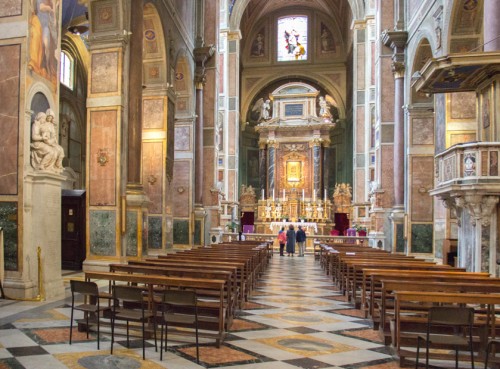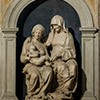Andrea Sansovino’s Madonna and Child with St. Anne – a work praised by poets

Interior of the Basilica of Sant’Agostino

Madonna with Child and St. Anne, Andrea Sansovino, Basilica of Sant'Agostino

Madonna with Child and St. Anne, Andrea Sansovino and the Prophet Isiah from Raphael, Basilica of Sant'Agostino

The Prophet Isiah from Raphael, Basilica of Sant'Agostino

Madonna with Child and St. Anne, Andrea Sansovino, Basilica of Sant'Agostino
In the Basilica of Sant’Agostino particular cult is enjoyed by the “Madonna of Childbirth” (Madonna del Parto). However we often forget another, also found in this church sculpture, which today does not attract attention, but in the past fascinated numerous art enthusiasts – mainly humanists. There are many poems praising the beauty of this group, which were annually read here during the Feast of St. Anne.
In the Basilica of Sant’Agostino particular cult is enjoyed by the “Madonna of Childbirth” (Madonna del Parto). However we often forget another, also found in this church sculpture, which today does not attract attention, but in the past fascinated numerous art enthusiasts – mainly humanists. There are many poems praising the beauty of this group, which were annually read here during the Feast of St. Anne.
However, before we take a closer look at the sculpture created by one of the most often praised in Renaissance Rome masters of the chisel – Andrea Sansovino, we must imagine the atmosphere of this city at the beginning of the XVI century – it was filled with admiration of poetry and art, accompanied by a veritable plethora of literary talents. Wealthy patrons surrounded themselves with poets writing in Latin, ancient poems were read, people gathered at literary suppers. Such a patron of the art of poetry was the Luxembourg-born, Apostolic Protonotary (a papal official responsible for the writing down of the most important documents and acts) Johannes Goritz, in Italian referred to as Giovanni Coricio – a humanist and an erudite, as well as a writer and collector by choice. And it was he who ordered a marble sculpture, for the today nonexistent Altar of St. Anne in the Church of Sant’Agostino, depicting Our Lady with Child accompanied by St. Anne, as well as – from Raphael – a fresco entitled The Prophet Isiah. The authors of the works were, therefore, the most famous artists of that time, active in the city upon the Tiber and that is exactly what the client had in mind. His sarcophagus was to be placed below these two significant masterpieces.
Each year at the Feast of St. Anne (July 26th) at the invitation of Goritz, the literary and artistic elite gathered in the Church of Sant’Agostino. The guests, mainly masters of the quill (reportedly around 120), delivered their speeches and read their poems, directing them towards St. Anne, while at the same time praising their host as well as the creators of the works found inside and finally the works themselves. After this poetic ceremony, the participants took part in the Eucharist, and then en masse moved to the villa of the Protonotary (on the premises of the Forum of Trajan), where in the garden a feast took place.
Subsequent centuries changed the location of the chapel, separating its elements. Today we can witness its remains – two interesting works, ordered by Goritz, a great admirer of St. Anne. Their choice was by no means accidental. And while the prophet Isiah, foresaw the coming of Christ – the Messiah, the sculpture group found in the niche was to remind all of his human genealogy, emphasizing at the same time, the role of the mother but also the grandmother of the Savior. Upon taking a closer look, we can notice several interesting elements. Anne embracing Mary is seated higher, her leg is leaning on a box for documents (the client's attribute) and visibly towers over her daughter. The other hand seems to be tickling the foot of the Child, resting in his mother's arms. And it is towards the grandmother that Jesus directs his gaze. The Virgin only delicately supports her son, since the ethereal body seems to weigh as much as feathers. This relation between grandson and grandmother is especially visible here – as if Mary’s only role was to act as an ideally beautiful support, which serves as a means of establishing contact between the two other figures.
At the same time, the contrast between the ideally beautiful face of the Madonna, with the old visage of Anne – two completely different figures sculpted in marble – had to present itself as new quality in the eyes of the viewers. Sansovino, as was fit for an artist of the Renaissance, looked to antiquity and placed in front of us Our Lady – stylized as a matron similar to a goddess – and the touched by time, toothless Anne, all the while creating a work with an intimate atmosphere, a vision of household bliss, bereft of the aura of sainthood. And only the goldfinch held by Jesus (the symbol of passion) appears to be foreshadowing the words of the prophet Isiah about the coming of the Messiah – from his birth through his teaching, all the way to his death.
The historiographer who described the sculpture, a contemporary of Sansovino, Giorgio Vasari, could not hide his admiration. In his opinion, no one had previously created a thing of such beauty with such a strong religious message.
Madonna with Child and St. Anne, Andrea Sansovino, 1512, marble, Church of Sant’Agostino


















